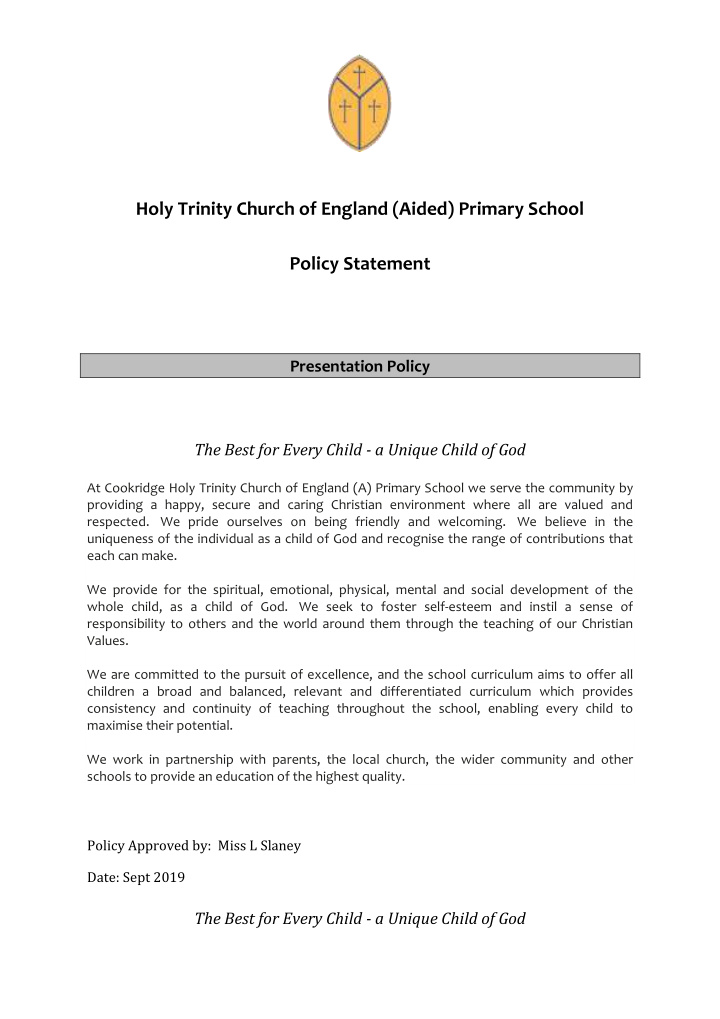



Holy Trinity Church of England (Aided) Primary School Policy Statement Presentation Policy The Best for Every Child - a Unique Child of God At Cookridge Holy Trinity Church of England (A) Primary School we serve the community by providing a happy, secure and caring Christian environment where all are valued and respected. We pride ourselves on being friendly and welcoming. We believe in the uniqueness of the individual as a child of God and recognise the range of contributions that each can make. We provide for the spiritual, emotional, physical, mental and social development of the whole child, as a child of God. We seek to foster self-esteem and instil a sense of responsibility to others and the world around them through the teaching of our Christian Values. We are committed to the pursuit of excellence, and the school curriculum aims to offer all children a broad and balanced, relevant and differentiated curriculum which provides consistency and continuity of teaching throughout the school, enabling every child to maximise their potential. We work in partnership with parents, the local church, the wider community and other schools to provide an education of the highest quality. Policy Approved by: Miss L Slaney Date: Sept 2019 The Best for Every Child - a Unique Child of God
To be reviewed: Sept 2020 Presentation Policy As a school we have common high expectations and standards regarding presentation. Children ’ s work is encouraged to be neat and of a high standard; presented in a clear and organised way and in a variety of forms. We use a continuous cursive handwriting style throughout school. In Reception and Key Stage1 pupils write using pencil. We place a high importance on teaching correct pencil grip and letter formation in Reception and Year 1. From Reception, children will learn: how a letter sounds, what it looks like and how we write it. They will be taught cursive joins on individual letters, to prepare them for using a joined script. This will continue into Year 1. We begin to teach a joined script in Year 2, in line with National Curriculum objectives. From Year 2 onwards, pupils can progress onto handwriting pen when they are writing consistently neatly and legibly using joined script in all their books. A pen licence is presented to the pupil when this happens. If presentation standards slip, they can have their licence revoked. Handwriting will be re- assessed at the start of each academic year when pupils move classes, during a trial period. Children are given their first handwriting pen free from the school office, and then can purchase their own or buy a replacement for £1. We ask children to use gel pen/handwriting pen rather than biro, unless it is deemed more appropriate by the teacher e.g. to avoid smudging/where children have poor fine motor skills. Left-handed pens can be ordered on request via the Literacy leader. Ink re-fills are available from the office via the class teacher. Some classroom labels and resources around school are written or printed using cursive script so the children see it being used around them. Teachers will endeavour to mark books using a cursive script to encourage high standards. Rules for presentation of Literacy and other Foundation Subjects 1. Write the date in word form on the left of the page next to the margin and underline using a ruler. 2. Copy the learning objective from the board onto the next line and underline using a ruler. 3. Miss a line before you start your work. 4. Write any numbers neatly in the margin. 5. Draw a neat line through any mistakes using a ruler. 6. Use all the space on every page. 7. Write neatly in joined script (Key Stage 2) at all times using either your pencil or pen. The Best for Every Child - a Unique Child of God
Rules for Maths presentation. 1. Write the date in digit form on the left of the page and underline using a ruler. 2. Copy the learning objective from the board and underline using a ruler. 3. Use only one digit per square. 4. Use a ruler for all straight lines and answer boxes. 5. Use pencil for all Maths work. 6. Use all of every page, drawing a line down the middle where appropriate for number work Guidance for cursive handwriting presentation. 1. All letters should ‘ sit ’ on the line. 2. Ascenders should be the same size as capital letters 3. Descenders should hang below the line and join as appropriate 4. Capital letters do not join and should be larger than lower case letters 5. Dots and crosses should be added at the end of words 6. Appropriate spacing should be left between words The Best for Every Child - a Unique Child of God
Recommend
More recommend